Nrsg 366 Partnerships in Chronicity
VerifiedAdded on 2023/04/21
|7
|2373
|54
AI Summary
Nursing like any other profession requires a set of skills to carry out the designated duties and responsibilities efficiently. Clinical thinking and reasoning are among the many skills that nurses and other medical practitioners should possess to formulate the best approach in any given medical situation.
Contribute Materials
Your contribution can guide someone’s learning journey. Share your
documents today.
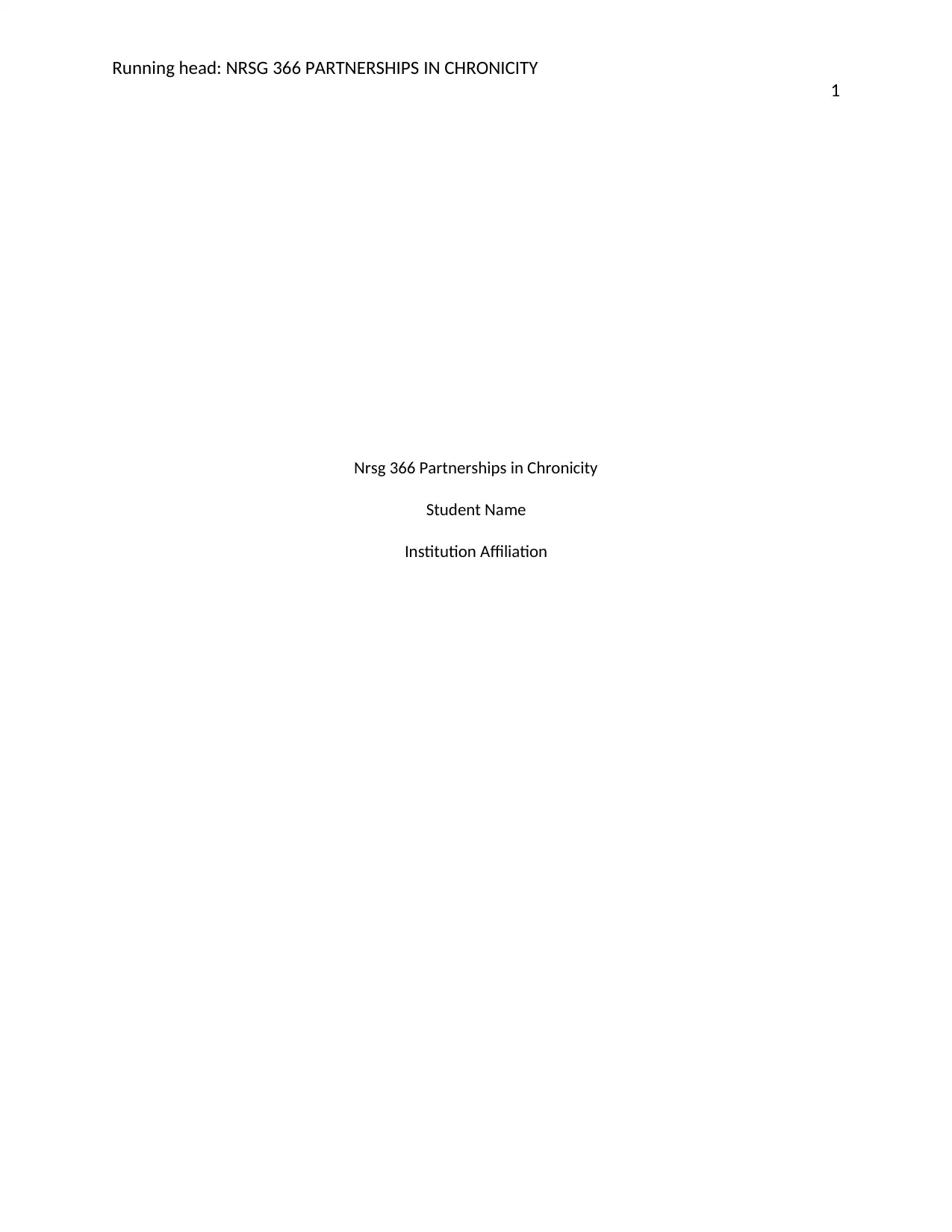
Running head: NRSG 366 PARTNERSHIPS IN CHRONICITY
1
Nrsg 366 Partnerships in Chronicity
Student Name
Institution Affiliation
1
Nrsg 366 Partnerships in Chronicity
Student Name
Institution Affiliation
Secure Best Marks with AI Grader
Need help grading? Try our AI Grader for instant feedback on your assignments.
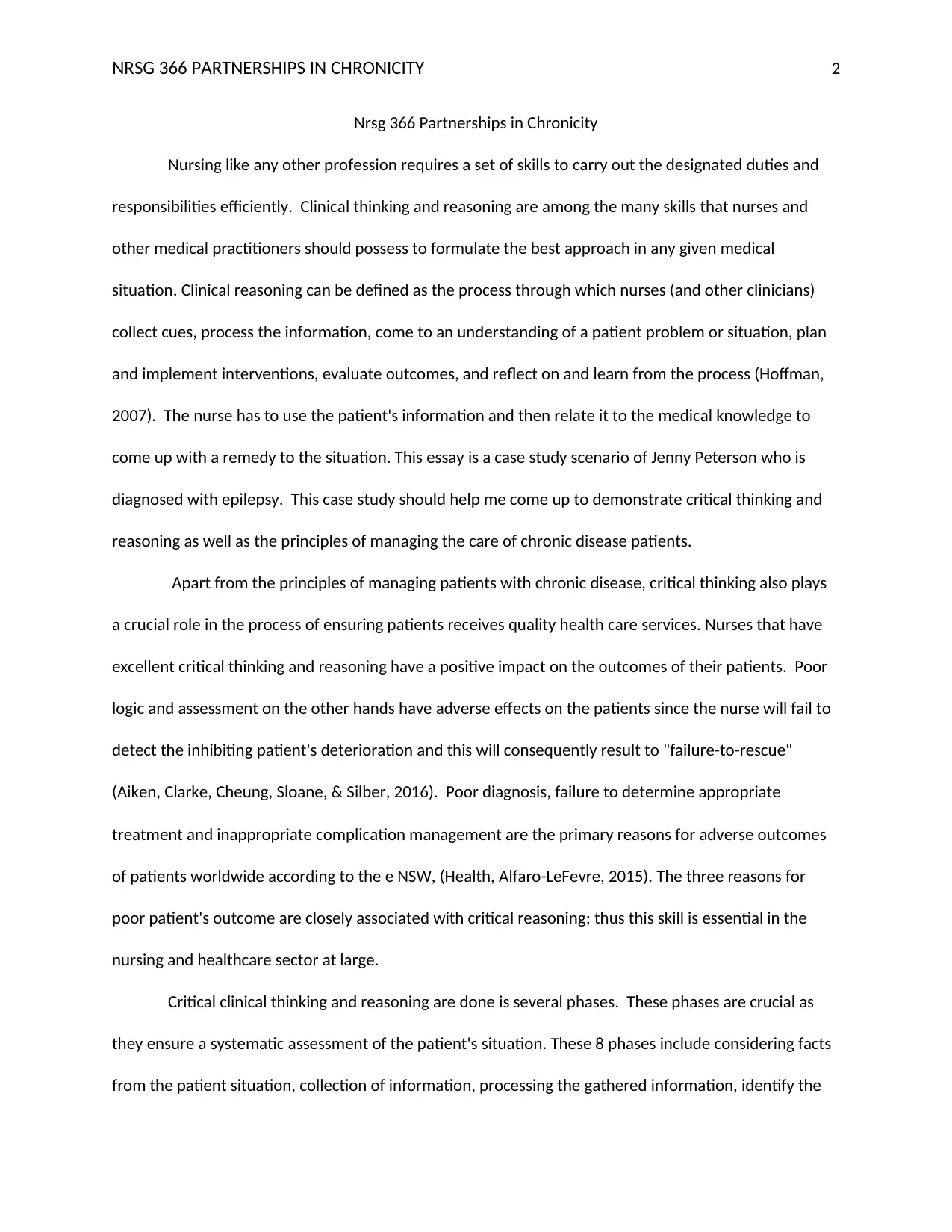
NRSG 366 PARTNERSHIPS IN CHRONICITY 2
Nrsg 366 Partnerships in Chronicity
Nursing like any other profession requires a set of skills to carry out the designated duties and
responsibilities efficiently. Clinical thinking and reasoning are among the many skills that nurses and
other medical practitioners should possess to formulate the best approach in any given medical
situation. Clinical reasoning can be defined as the process through which nurses (and other clinicians)
collect cues, process the information, come to an understanding of a patient problem or situation, plan
and implement interventions, evaluate outcomes, and reflect on and learn from the process (Hoffman,
2007). The nurse has to use the patient's information and then relate it to the medical knowledge to
come up with a remedy to the situation. This essay is a case study scenario of Jenny Peterson who is
diagnosed with epilepsy. This case study should help me come up to demonstrate critical thinking and
reasoning as well as the principles of managing the care of chronic disease patients.
Apart from the principles of managing patients with chronic disease, critical thinking also plays
a crucial role in the process of ensuring patients receives quality health care services. Nurses that have
excellent critical thinking and reasoning have a positive impact on the outcomes of their patients. Poor
logic and assessment on the other hands have adverse effects on the patients since the nurse will fail to
detect the inhibiting patient's deterioration and this will consequently result to "failure-to-rescue"
(Aiken, Clarke, Cheung, Sloane, & Silber, 2016). Poor diagnosis, failure to determine appropriate
treatment and inappropriate complication management are the primary reasons for adverse outcomes
of patients worldwide according to the e NSW, (Health, Alfaro-LeFevre, 2015). The three reasons for
poor patient's outcome are closely associated with critical reasoning; thus this skill is essential in the
nursing and healthcare sector at large.
Critical clinical thinking and reasoning are done is several phases. These phases are crucial as
they ensure a systematic assessment of the patient's situation. These 8 phases include considering facts
from the patient situation, collection of information, processing the gathered information, identify the
Nrsg 366 Partnerships in Chronicity
Nursing like any other profession requires a set of skills to carry out the designated duties and
responsibilities efficiently. Clinical thinking and reasoning are among the many skills that nurses and
other medical practitioners should possess to formulate the best approach in any given medical
situation. Clinical reasoning can be defined as the process through which nurses (and other clinicians)
collect cues, process the information, come to an understanding of a patient problem or situation, plan
and implement interventions, evaluate outcomes, and reflect on and learn from the process (Hoffman,
2007). The nurse has to use the patient's information and then relate it to the medical knowledge to
come up with a remedy to the situation. This essay is a case study scenario of Jenny Peterson who is
diagnosed with epilepsy. This case study should help me come up to demonstrate critical thinking and
reasoning as well as the principles of managing the care of chronic disease patients.
Apart from the principles of managing patients with chronic disease, critical thinking also plays
a crucial role in the process of ensuring patients receives quality health care services. Nurses that have
excellent critical thinking and reasoning have a positive impact on the outcomes of their patients. Poor
logic and assessment on the other hands have adverse effects on the patients since the nurse will fail to
detect the inhibiting patient's deterioration and this will consequently result to "failure-to-rescue"
(Aiken, Clarke, Cheung, Sloane, & Silber, 2016). Poor diagnosis, failure to determine appropriate
treatment and inappropriate complication management are the primary reasons for adverse outcomes
of patients worldwide according to the e NSW, (Health, Alfaro-LeFevre, 2015). The three reasons for
poor patient's outcome are closely associated with critical reasoning; thus this skill is essential in the
nursing and healthcare sector at large.
Critical clinical thinking and reasoning are done is several phases. These phases are crucial as
they ensure a systematic assessment of the patient's situation. These 8 phases include considering facts
from the patient situation, collection of information, processing the gathered information, identify the
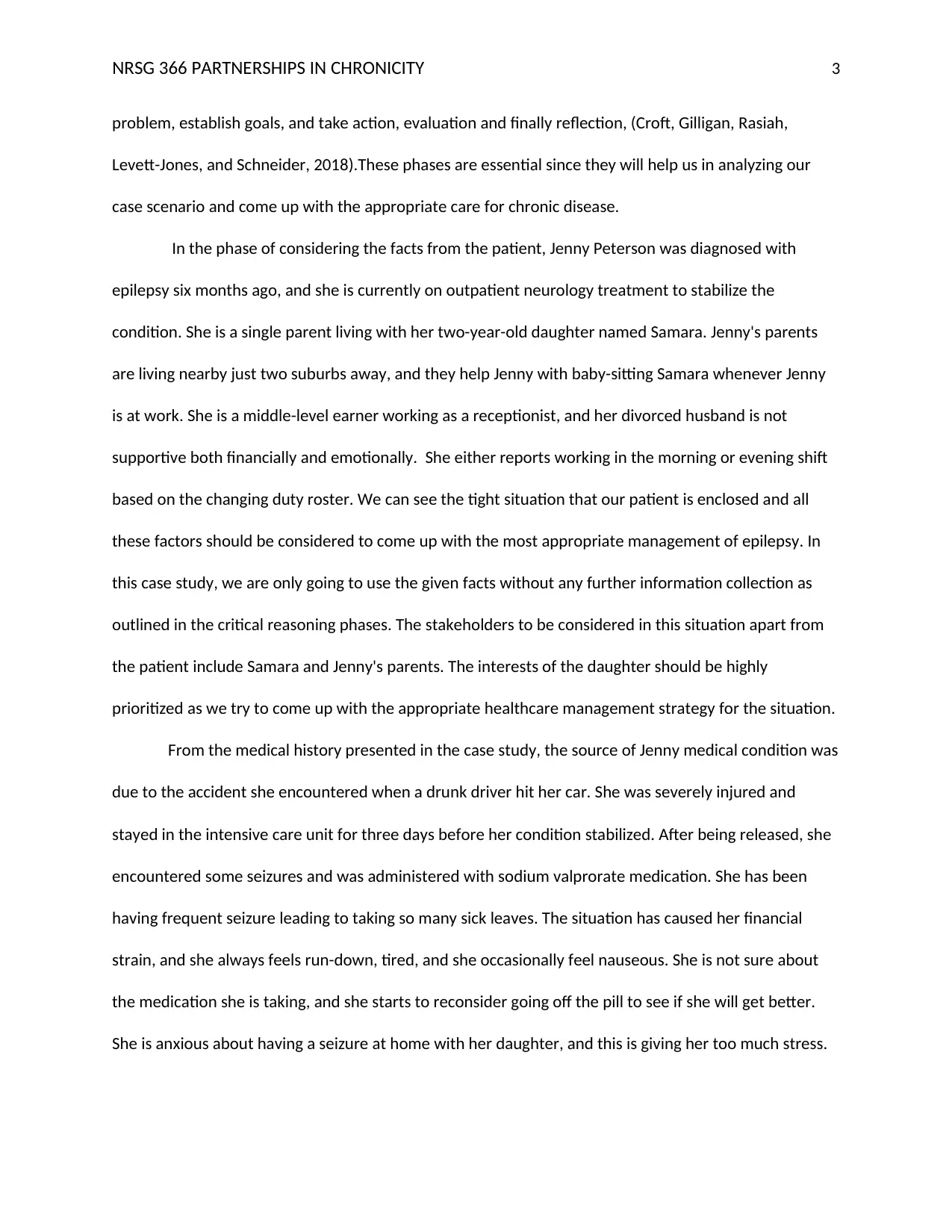
NRSG 366 PARTNERSHIPS IN CHRONICITY 3
problem, establish goals, and take action, evaluation and finally reflection, (Croft, Gilligan, Rasiah,
Levett-Jones, and Schneider, 2018).These phases are essential since they will help us in analyzing our
case scenario and come up with the appropriate care for chronic disease.
In the phase of considering the facts from the patient, Jenny Peterson was diagnosed with
epilepsy six months ago, and she is currently on outpatient neurology treatment to stabilize the
condition. She is a single parent living with her two-year-old daughter named Samara. Jenny's parents
are living nearby just two suburbs away, and they help Jenny with baby-sitting Samara whenever Jenny
is at work. She is a middle-level earner working as a receptionist, and her divorced husband is not
supportive both financially and emotionally. She either reports working in the morning or evening shift
based on the changing duty roster. We can see the tight situation that our patient is enclosed and all
these factors should be considered to come up with the most appropriate management of epilepsy. In
this case study, we are only going to use the given facts without any further information collection as
outlined in the critical reasoning phases. The stakeholders to be considered in this situation apart from
the patient include Samara and Jenny's parents. The interests of the daughter should be highly
prioritized as we try to come up with the appropriate healthcare management strategy for the situation.
From the medical history presented in the case study, the source of Jenny medical condition was
due to the accident she encountered when a drunk driver hit her car. She was severely injured and
stayed in the intensive care unit for three days before her condition stabilized. After being released, she
encountered some seizures and was administered with sodium valprorate medication. She has been
having frequent seizure leading to taking so many sick leaves. The situation has caused her financial
strain, and she always feels run-down, tired, and she occasionally feel nauseous. She is not sure about
the medication she is taking, and she starts to reconsider going off the pill to see if she will get better.
She is anxious about having a seizure at home with her daughter, and this is giving her too much stress.
problem, establish goals, and take action, evaluation and finally reflection, (Croft, Gilligan, Rasiah,
Levett-Jones, and Schneider, 2018).These phases are essential since they will help us in analyzing our
case scenario and come up with the appropriate care for chronic disease.
In the phase of considering the facts from the patient, Jenny Peterson was diagnosed with
epilepsy six months ago, and she is currently on outpatient neurology treatment to stabilize the
condition. She is a single parent living with her two-year-old daughter named Samara. Jenny's parents
are living nearby just two suburbs away, and they help Jenny with baby-sitting Samara whenever Jenny
is at work. She is a middle-level earner working as a receptionist, and her divorced husband is not
supportive both financially and emotionally. She either reports working in the morning or evening shift
based on the changing duty roster. We can see the tight situation that our patient is enclosed and all
these factors should be considered to come up with the most appropriate management of epilepsy. In
this case study, we are only going to use the given facts without any further information collection as
outlined in the critical reasoning phases. The stakeholders to be considered in this situation apart from
the patient include Samara and Jenny's parents. The interests of the daughter should be highly
prioritized as we try to come up with the appropriate healthcare management strategy for the situation.
From the medical history presented in the case study, the source of Jenny medical condition was
due to the accident she encountered when a drunk driver hit her car. She was severely injured and
stayed in the intensive care unit for three days before her condition stabilized. After being released, she
encountered some seizures and was administered with sodium valprorate medication. She has been
having frequent seizure leading to taking so many sick leaves. The situation has caused her financial
strain, and she always feels run-down, tired, and she occasionally feel nauseous. She is not sure about
the medication she is taking, and she starts to reconsider going off the pill to see if she will get better.
She is anxious about having a seizure at home with her daughter, and this is giving her too much stress.

NRSG 366 PARTNERSHIPS IN CHRONICITY 4
In such a scenario, the seizure can easily lead to death and also Samara will be adversely affected if
immediate intervention is not taken.
Epilepsy is a chronic disease, and there is various medication that can be used to prevent
seizures in both children and adults. Jenny is under sodium valprorate 200 mg daily and lamotrigine 200
mg daily. Like any other drugs, these two have their side effects, and it varies from one patient to
another. There are several factors such as allergic reaction and genetic make-up that determine the
effectiveness of any drug. Therefore, as much as the drugs have controlled the seizures, Jenny is still
feeling tired, nauseous and experiences diarrhea. Thus as a nurse, based on the given information and
using critical clinical reasoning we can realize that Jenny is suffering the side effects of these drugs.
Sodium valproate is a common drug used to treat bipolar disorder and epilepsy. It also prescribed to
patients suffering from migraine headaches. Its dosage can either be taken once a day or twice a day
according to the doctor's prescription. This medication is usually started on a low dose and then it is
gradually increased to the appropriate treatment, (Gill, Derry, Wiffen, and Moore, 2018). The most
common side effects of sodium valproate include passing out, feeling confused, breathing problems,
feeling dizzy or headaches as well as nausea and vomiting. Jenny for her case, she feels tired, run down
and nauseous which are among the above side effects of the drug, (Yanagisawa, 2016). Therefore it is
clear that as much as the seizures have been prevented the doctor should consider how the side effects
of the medication can be mitigated. Lamictal (lamotrigine) is a medication used to treat some types of
seizures, (Samuel, Sehar, Afzal, and Gilani, 2018)). The drug can be used independently or in
combination with other medicines to treat epilepsy. The drug, like any other drug, has a side effect. The
side effects were maybe ranging from severe dizziness to mild loss of coordination.
It is evident that Jenny Peterson is experiencing the side effects of the medication and this must
be considered to get a positive patient outcome in this situation. The two priority mechanisms to deal
with this situation from the medical point of view are to change medication or prescribe a different
In such a scenario, the seizure can easily lead to death and also Samara will be adversely affected if
immediate intervention is not taken.
Epilepsy is a chronic disease, and there is various medication that can be used to prevent
seizures in both children and adults. Jenny is under sodium valprorate 200 mg daily and lamotrigine 200
mg daily. Like any other drugs, these two have their side effects, and it varies from one patient to
another. There are several factors such as allergic reaction and genetic make-up that determine the
effectiveness of any drug. Therefore, as much as the drugs have controlled the seizures, Jenny is still
feeling tired, nauseous and experiences diarrhea. Thus as a nurse, based on the given information and
using critical clinical reasoning we can realize that Jenny is suffering the side effects of these drugs.
Sodium valproate is a common drug used to treat bipolar disorder and epilepsy. It also prescribed to
patients suffering from migraine headaches. Its dosage can either be taken once a day or twice a day
according to the doctor's prescription. This medication is usually started on a low dose and then it is
gradually increased to the appropriate treatment, (Gill, Derry, Wiffen, and Moore, 2018). The most
common side effects of sodium valproate include passing out, feeling confused, breathing problems,
feeling dizzy or headaches as well as nausea and vomiting. Jenny for her case, she feels tired, run down
and nauseous which are among the above side effects of the drug, (Yanagisawa, 2016). Therefore it is
clear that as much as the seizures have been prevented the doctor should consider how the side effects
of the medication can be mitigated. Lamictal (lamotrigine) is a medication used to treat some types of
seizures, (Samuel, Sehar, Afzal, and Gilani, 2018)). The drug can be used independently or in
combination with other medicines to treat epilepsy. The drug, like any other drug, has a side effect. The
side effects were maybe ranging from severe dizziness to mild loss of coordination.
It is evident that Jenny Peterson is experiencing the side effects of the medication and this must
be considered to get a positive patient outcome in this situation. The two priority mechanisms to deal
with this situation from the medical point of view are to change medication or prescribe a different
Secure Best Marks with AI Grader
Need help grading? Try our AI Grader for instant feedback on your assignments.
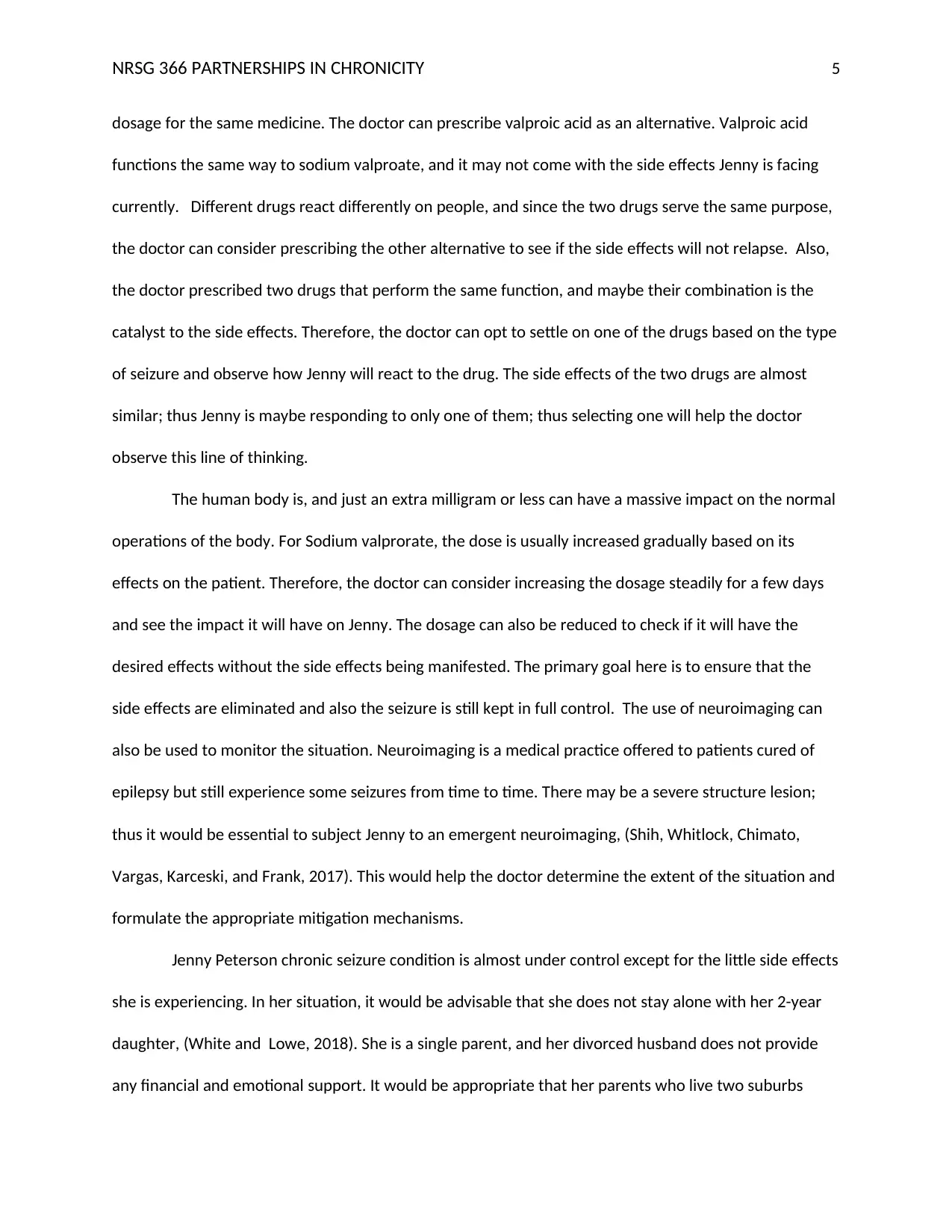
NRSG 366 PARTNERSHIPS IN CHRONICITY 5
dosage for the same medicine. The doctor can prescribe valproic acid as an alternative. Valproic acid
functions the same way to sodium valproate, and it may not come with the side effects Jenny is facing
currently. Different drugs react differently on people, and since the two drugs serve the same purpose,
the doctor can consider prescribing the other alternative to see if the side effects will not relapse. Also,
the doctor prescribed two drugs that perform the same function, and maybe their combination is the
catalyst to the side effects. Therefore, the doctor can opt to settle on one of the drugs based on the type
of seizure and observe how Jenny will react to the drug. The side effects of the two drugs are almost
similar; thus Jenny is maybe responding to only one of them; thus selecting one will help the doctor
observe this line of thinking.
The human body is, and just an extra milligram or less can have a massive impact on the normal
operations of the body. For Sodium valprorate, the dose is usually increased gradually based on its
effects on the patient. Therefore, the doctor can consider increasing the dosage steadily for a few days
and see the impact it will have on Jenny. The dosage can also be reduced to check if it will have the
desired effects without the side effects being manifested. The primary goal here is to ensure that the
side effects are eliminated and also the seizure is still kept in full control. The use of neuroimaging can
also be used to monitor the situation. Neuroimaging is a medical practice offered to patients cured of
epilepsy but still experience some seizures from time to time. There may be a severe structure lesion;
thus it would be essential to subject Jenny to an emergent neuroimaging, (Shih, Whitlock, Chimato,
Vargas, Karceski, and Frank, 2017). This would help the doctor determine the extent of the situation and
formulate the appropriate mitigation mechanisms.
Jenny Peterson chronic seizure condition is almost under control except for the little side effects
she is experiencing. In her situation, it would be advisable that she does not stay alone with her 2-year
daughter, (White and Lowe, 2018). She is a single parent, and her divorced husband does not provide
any financial and emotional support. It would be appropriate that her parents who live two suburbs
dosage for the same medicine. The doctor can prescribe valproic acid as an alternative. Valproic acid
functions the same way to sodium valproate, and it may not come with the side effects Jenny is facing
currently. Different drugs react differently on people, and since the two drugs serve the same purpose,
the doctor can consider prescribing the other alternative to see if the side effects will not relapse. Also,
the doctor prescribed two drugs that perform the same function, and maybe their combination is the
catalyst to the side effects. Therefore, the doctor can opt to settle on one of the drugs based on the type
of seizure and observe how Jenny will react to the drug. The side effects of the two drugs are almost
similar; thus Jenny is maybe responding to only one of them; thus selecting one will help the doctor
observe this line of thinking.
The human body is, and just an extra milligram or less can have a massive impact on the normal
operations of the body. For Sodium valprorate, the dose is usually increased gradually based on its
effects on the patient. Therefore, the doctor can consider increasing the dosage steadily for a few days
and see the impact it will have on Jenny. The dosage can also be reduced to check if it will have the
desired effects without the side effects being manifested. The primary goal here is to ensure that the
side effects are eliminated and also the seizure is still kept in full control. The use of neuroimaging can
also be used to monitor the situation. Neuroimaging is a medical practice offered to patients cured of
epilepsy but still experience some seizures from time to time. There may be a severe structure lesion;
thus it would be essential to subject Jenny to an emergent neuroimaging, (Shih, Whitlock, Chimato,
Vargas, Karceski, and Frank, 2017). This would help the doctor determine the extent of the situation and
formulate the appropriate mitigation mechanisms.
Jenny Peterson chronic seizure condition is almost under control except for the little side effects
she is experiencing. In her situation, it would be advisable that she does not stay alone with her 2-year
daughter, (White and Lowe, 2018). She is a single parent, and her divorced husband does not provide
any financial and emotional support. It would be appropriate that her parents who live two suburbs
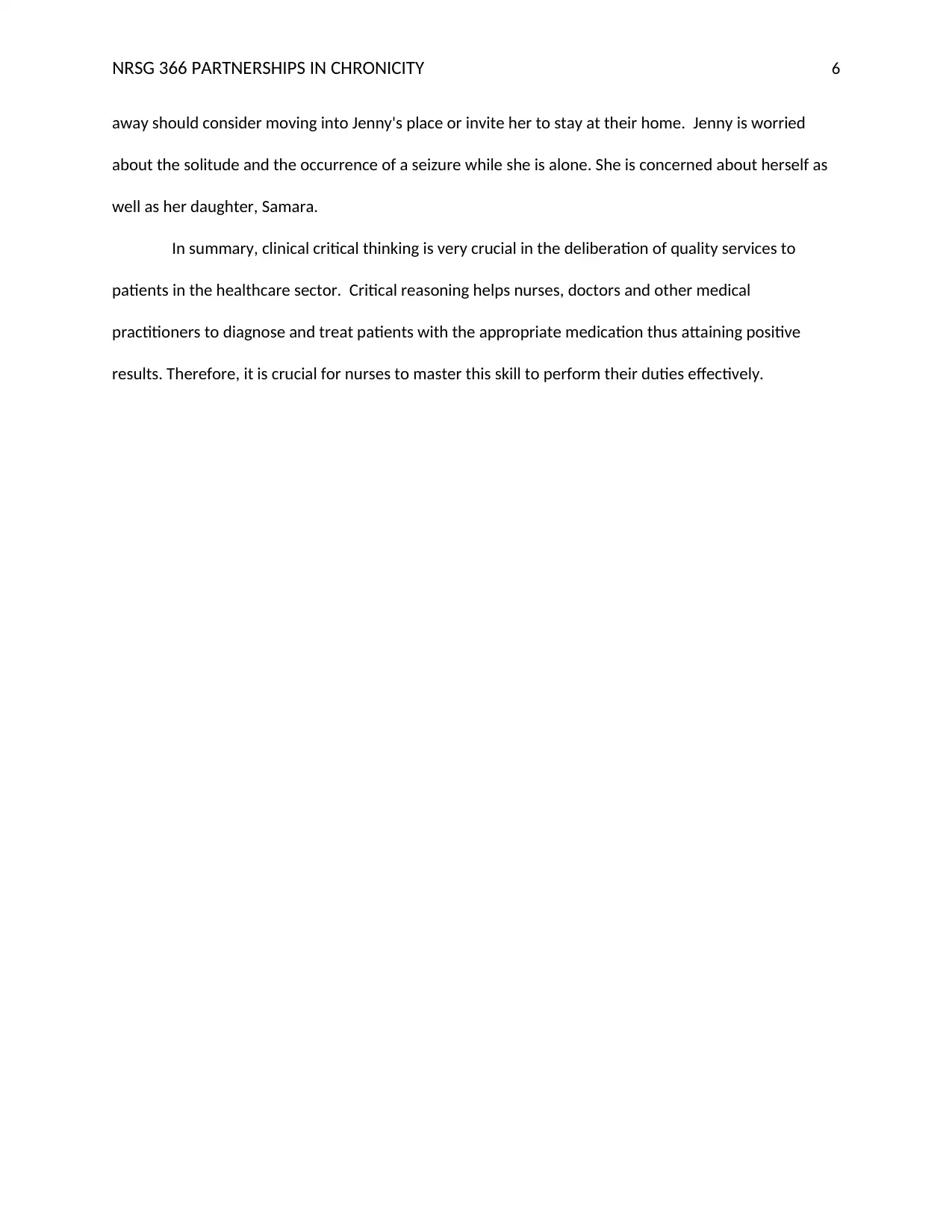
NRSG 366 PARTNERSHIPS IN CHRONICITY 6
away should consider moving into Jenny's place or invite her to stay at their home. Jenny is worried
about the solitude and the occurrence of a seizure while she is alone. She is concerned about herself as
well as her daughter, Samara.
In summary, clinical critical thinking is very crucial in the deliberation of quality services to
patients in the healthcare sector. Critical reasoning helps nurses, doctors and other medical
practitioners to diagnose and treat patients with the appropriate medication thus attaining positive
results. Therefore, it is crucial for nurses to master this skill to perform their duties effectively.
away should consider moving into Jenny's place or invite her to stay at their home. Jenny is worried
about the solitude and the occurrence of a seizure while she is alone. She is concerned about herself as
well as her daughter, Samara.
In summary, clinical critical thinking is very crucial in the deliberation of quality services to
patients in the healthcare sector. Critical reasoning helps nurses, doctors and other medical
practitioners to diagnose and treat patients with the appropriate medication thus attaining positive
results. Therefore, it is crucial for nurses to master this skill to perform their duties effectively.

NRSG 366 PARTNERSHIPS IN CHRONICITY 7
References
Aiken, L.H., Clarke, S.P., Cheung, R.B., Sloane, D.M. and Silber, J.H. (2018) Educational
Alfaro-LeFevre, R. (2018). Critical thinking and clinical judgment: A practical approach to
and "novice" nurses in the clinical setting, monitoring patient hemodynamic status
Croft, H., Gilligan, C., Rasiah, R., Levett-Jones, T., & Schneider, J. (2018). Thinking in pharmacy practice: a
study of community pharmacists’ clinical reasoning in medication supply using the think-aloud
method. Pharmacy, 6(1), 1.
decision-making. Journal of Nursing Education, 41(4), 145–154.
Gill, D., Derry, S., Wiffen, P. J., & Moore, R. A. (2018). Valproic acid and sodium valproate for
neuropathic pain and fibromyalgia in adults. Cochrane Database of Systematic Reviews, (10).
Gullick, J., Lin, F., Massey, D., Wilson, L., Greenwood, M., Skylas, K., ... & Gill, F. J. (2018). Structures,
processes and outcomes of specialist critical care nurse education: an integrative review.
Australian Critical Care.
Hoffman, K. (2018).Unpublished Ph.D. thesis, A comparison of decision-making by "expert."
Levels of hospital nurses and surgical patient mortality. JAMA. 290 (12), 1617–1620.
Nursing. Journal of Nursing Education, 45(6), 204-211
outcome-focused thinking. (4th ed.). St Louis: Elsevier.
Post-abdominal aortic aneurysm surgery. University of Technology, Sydney.
Samuel, H., Sehar, S., Afzal, M., & Gilani, S. A. (2018). Influence of Supportive Leadership on Nursing
Clinical Decision making in Critical Care Units at Tertiary Care Hospital Lahore. International
Journal of Nursing, 5(2), 45-71.
Shih, J. J., Whitlock, J. B., Chimato, N., Vargas, E., Karceski, S. C., & Frank, R. D. (2018). Epilepsy treatment
in adults and adolescents: expert opinion, 2016. Epilepsy & Behavior, 69, 186-222.
White, S. J., & Lowe, F. (2018). Respiratory failure. Critical Care Nursing: the Humanised Approach, 69.
Yanagisawa, K. (2018). Transition of Psychotropic Drugs in Japanese Pharmacopoeia (JP)(Part 17)
Transitions in the Standards and Test Methods of Valproic Acid and Sodium Valproate in
Japanese Pharmacopoeia (JP), Pharmacopoeia of the USA (USP), British Pharmacopoeia (BP),
and the Knowledge and Judgment about Japanese Valeriana, and Valproic Acid from Valeric
Acid. Yakushigaku Zasshi, 51(1), 40-57.
References
Aiken, L.H., Clarke, S.P., Cheung, R.B., Sloane, D.M. and Silber, J.H. (2018) Educational
Alfaro-LeFevre, R. (2018). Critical thinking and clinical judgment: A practical approach to
and "novice" nurses in the clinical setting, monitoring patient hemodynamic status
Croft, H., Gilligan, C., Rasiah, R., Levett-Jones, T., & Schneider, J. (2018). Thinking in pharmacy practice: a
study of community pharmacists’ clinical reasoning in medication supply using the think-aloud
method. Pharmacy, 6(1), 1.
decision-making. Journal of Nursing Education, 41(4), 145–154.
Gill, D., Derry, S., Wiffen, P. J., & Moore, R. A. (2018). Valproic acid and sodium valproate for
neuropathic pain and fibromyalgia in adults. Cochrane Database of Systematic Reviews, (10).
Gullick, J., Lin, F., Massey, D., Wilson, L., Greenwood, M., Skylas, K., ... & Gill, F. J. (2018). Structures,
processes and outcomes of specialist critical care nurse education: an integrative review.
Australian Critical Care.
Hoffman, K. (2018).Unpublished Ph.D. thesis, A comparison of decision-making by "expert."
Levels of hospital nurses and surgical patient mortality. JAMA. 290 (12), 1617–1620.
Nursing. Journal of Nursing Education, 45(6), 204-211
outcome-focused thinking. (4th ed.). St Louis: Elsevier.
Post-abdominal aortic aneurysm surgery. University of Technology, Sydney.
Samuel, H., Sehar, S., Afzal, M., & Gilani, S. A. (2018). Influence of Supportive Leadership on Nursing
Clinical Decision making in Critical Care Units at Tertiary Care Hospital Lahore. International
Journal of Nursing, 5(2), 45-71.
Shih, J. J., Whitlock, J. B., Chimato, N., Vargas, E., Karceski, S. C., & Frank, R. D. (2018). Epilepsy treatment
in adults and adolescents: expert opinion, 2016. Epilepsy & Behavior, 69, 186-222.
White, S. J., & Lowe, F. (2018). Respiratory failure. Critical Care Nursing: the Humanised Approach, 69.
Yanagisawa, K. (2018). Transition of Psychotropic Drugs in Japanese Pharmacopoeia (JP)(Part 17)
Transitions in the Standards and Test Methods of Valproic Acid and Sodium Valproate in
Japanese Pharmacopoeia (JP), Pharmacopoeia of the USA (USP), British Pharmacopoeia (BP),
and the Knowledge and Judgment about Japanese Valeriana, and Valproic Acid from Valeric
Acid. Yakushigaku Zasshi, 51(1), 40-57.
1 out of 7
Related Documents
Your All-in-One AI-Powered Toolkit for Academic Success.
+13062052269
info@desklib.com
Available 24*7 on WhatsApp / Email
![[object Object]](/_next/static/media/star-bottom.7253800d.svg)
Unlock your academic potential
© 2024 | Zucol Services PVT LTD | All rights reserved.





